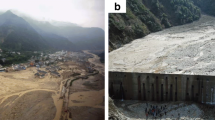We performed a series of experiments aimed at the investigation of the propagation of pitting corrosion in stainless steels. A collection of fragments of the surface damaged by pitting corrosion was obtained with the help of the anode polarization of samples of materials in chlorine-containing media. For the analysis of their images, we used statistical modeling performed with the help of point processes. To model the mutual influence of pitting defects, we used Markov processes with pairwise interaction. It is shown that the characteristics of stochastic processes can be used for the determination of the correlation between pits.







Similar content being viewed by others
References
V. I. Pokhmurs’kyi and M. S. Khoma, Corrosion Fatigue of Metals and Alloys: A Monograph [in Ukrainian], Spolom, Lviv (2008).
M. A. Shluger, F. F. Azhogin, and E. A. Efimov, Corrosion and Protection of Metals [in Russian], Metallurgiya, Moscow (1981).
D. G. Tufanov, Corrosion Resistance of Stainless Steels, Alloys, and Pure Metals: A Handbook [in Russian], Metallurgiya, Moscow (1982).
P. M. Aziz, “Application of the statistical theory of extreme values to the analysis of maximum pit depth data for aluminum,” Corrosion, 12, No. 10, 35–46 (1956).
T. Shibata and T. Takeyama, “Stochastic theory of pitting corrosion,” Corrosion, 33, No. 7, 243–251 (1977).
D. E. Hawn, “Extreme value prediction of maximum pits on pipelines,” Mater. Performance, 16, 29–32 (1977).
A. Valor, F. Galeo, L. Alfonso, D. Rivas, and J. M. Hallen, “Stochastic modeling of pitting corrosion: A new model for initiation and growth of multiple corrosion pits,” Corros. Sci., 49, 559–579 (2007).
L. Organ, J. R. Scully, A. S. Mikhailov, and J. L. Hudson, “A spatiotemporal model of interactions among metastable pits and the transition to pitting corrosion,” Electrochim. Acta, 51, 225–241 (2005).
N. D. Budiansky, L. Organ, J. L. Hudson, and J. R. Scully, “Detection of interactions among localized pitting sites on stainless steel using spatial statistics,” J. Electrochem. Soc., 152, No. 4, B152–B160 (2005).
A. Valor, F. Caleyo, L. Alfonso, J. C. Velazkez, J. M. Hallen, and C. Markov, “Models for the stochastic modeling of pitting corrosion,” Math. Probl. Eng., 2013, Article ID 108386 (2013).
A. J. Baddeley and M. N. M. van Lieshout, “Area-interaction point processes,” Ann. Inst. Statist. Math., 47, No. 4, 601–619 (1995).
P. Grabarnik and A. Sarkka, “Interacting neighbor point processes: some models for clustering,” J. Statist. Comput. Simulat., 68, 103–126. (2001).
B. Ripley, “Test of randomness for spatial point patterns,” J. R. Statist. Soc. B, 41, No. 3, 368–374 (1979).
T. Fiksel, “Estimation of parametrized pair potentials of marked and nonmarked Gibbsian point processes,” Elektron. Inform. Kybernet,, 20, 270–278 (1984).
R. Ya. Kosarevych, “Segmentation of images with the use of the characteristics of point images,” Vidb. Obrob. Inf., Issue 36 (112), 91–97 (2012).
The R Project for Statistical Computing, http://cran.r-project.org.
J. Lopez De La Cruz, S. P. Kuniewski, J. M. Van Noortwijk, and M. A. Gutierrez, “Spatial nonhomogeneous Poisson point process in corrosion management,” J. Electrochem. Soc., 155, No. 8, C396–C406 (2008).
Author information
Authors and Affiliations
Corresponding author
Additional information
Translated from Fizyko-Khimichna Mekhanika Materialiv, Vol. 51, No. 5, pp. 75–81, September–October, 2015.
Rights and permissions
About this article
Cite this article
Kosarevych, R.Y., Rusyn, B.P. & Tors’ka, R.V. Modeling of the Propagation of Pitting Corrosion by Point Processes. Mater Sci 51, 673–681 (2016). https://doi.org/10.1007/s11003-016-9890-8
Received:
Published:
Issue Date:
DOI: https://doi.org/10.1007/s11003-016-9890-8




